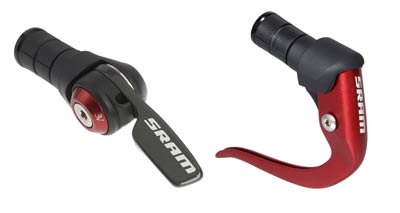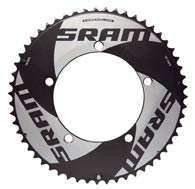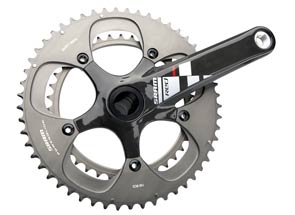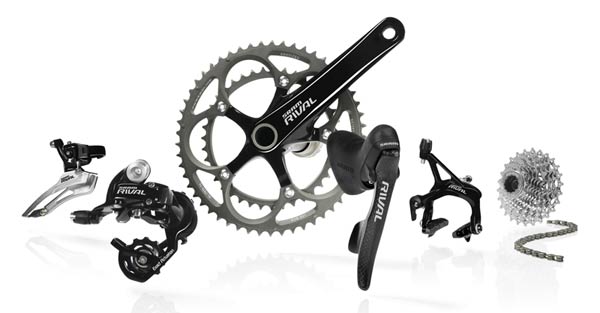2009 Rival
SRAM’s entry-level groupset Rival (RCUK review) was launched, along with its more expensive partner Force, in 2006. Since then the US-based company has not put its feet up, launching in 2007 its all-singing and dancing RED groupset.
RED introduced several notable developments from Rival and Force, and for 2009 SRAM is overhauling both groupsets by trickling down tech from RED. Rival is the most redesigned groupset, and most visually different is a new polished black anodised finish that RCUK thinks makes it look more expensive.
It’s not just the finish that has changed, for beneath the surface there’s plenty to talk about. Brake levers are now made from carbon (and 40g lighter) and are longer as on RED, for better ergonomics. Most importantly is the addition of Zero Loss Shifting, which as RCUK pointed out in its first ride of the RED grouppo, is the most appealing aspect of making the switch to SRAM’s offering.
The independent shift and brake lever adjustment also sees a presence, as well as multiple cable routing so you can pick whichever you prefer when building your bike. And like RED, the front derailleur now allows trim position on the big ring, which seems to work ok, but once RCUK gets a test, we’ll report on this change.
Lastly, the cranks have been taken back to the drawing board and designed around OCT (Open Core Technology), first seen on the company’s MTB products. The previous Rival cranks were simply forged with scalloped-out arms, but the new process is a proper hollow-forged design, making them 40g lighter than before.
These changes have reduced the weight of a complete Rival groupset to 2,149g.
2009 Force
Just like Rival, SRAM has given the same treatment to its middle-rung groupset, incorporating many of the updates seen in RED to make Force even more of a force to be reckoned with (ok I’ll get my coat…).
SRAM boast that Force has been ridden to 29 ProTour wins in 2007 which, for a company that only laid out its road intentions the year previously, is impressive. They’ve surely hit the ground running, and the current changes look to see them more than keeping up with the competition.
So expect Zero Loss Shifting, adjustable reach, longer brake lever, wider shift paddle, multiple cable routing, adjustable front trim and PowerGlide chainrings for slicker shifting. These changes bring the weight down by a few grams to 2,052g.
RED
For 2009 the SRAM RED groupset will be available with a new BB30 chainset. This free-to-use standard was created by Cannondale and is slowly being adopted by more companies, such as FSA and Zipp, of which the later was acquired by the SRAM corporation recently.


Time trial components for 2009 and a range of single rings available for RED time trial groupset
The OG-1090 ‘PowerDome’ cassette will be available in a wider choice of ratios. 11.25 and 11-28 will be introduced later this year. What cassette do you use? According to SRAM’s Product Manager Ron Ritzler, “The 11-25 is the perfect cassette for 98% of the World.” Well there you go.
SRAM’s intentions of competing on the professional road race stage have been clear since it launched its first groupsets, and no line-up would be complete without time trial components. Shifters and brake levers have already been spotted on pro bikes, but they’ve been updated for 2009.


Following SRAM’s acquisition of Zipp (the US company has already been working with Cannondale’s BB30 format), RED will now demo the new larger bottom bracket interface
The 500 TT aero brake levers now use a red anodized lever instead of carbon with the weight increasing only a small amount from 99g to 115g a pair. The 500 TT shift levers have been more a little less expensive, and now include a 3-position stop for precise cable release tuning. Weight is just 154g a pair.
Ridden to success in the Tour of California opening time trial, SRAM will be launching a TT chainring. Coming in 42, 54 and 55 tooth options, they’ll feature SRAM’s PowerGlide technology for precise shifting, with a hard anodized finish.






